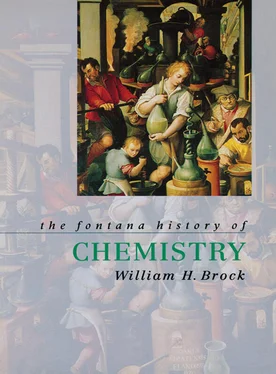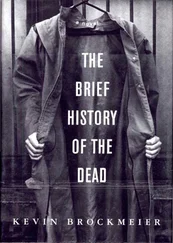By building bigger and more powerful batteries, and by using fused electrolytes rather than electrolytes in solution, Davy confirmed Lavoisier’s hunch that soda and potash were not elementary by isolating sodium and potassium in 1807. In the next few years he demonstrated that Lavoisier’s alkaline earths were also compounds and prepared calcium, strontium and barium electrolytically. Later still, Davy argued convincingly against the view that muriatic acid contained oxygen, and for the opinion that oxymuriatic acid, which he renamed chlorine, was an undecompounded elementary body – a point supported by his isolation of its conjoiner, iodine, in 1813.
This succession of corrections to Lavoisier’s chemistry has led some historians to feel that Davy set out systematically to destroy French chemistry. Indeed, by 1815 he had critically and effectively questioned most of the assumptions of the antiphlogistic chemistry – that acidity was due to oxygen, that properties were due to ‘principles’ rather than arrangement, that heat was an imponderable fluid rather than a motion of particles, and that Lavoisier’s elements were truly elementary. Although Davy was often bold in his speculations and use of analogical reasoning, in stripping Lavoisier’s system to its empirical essentials he did not replace it with any grand system of his own, except to suggest that chemical affinity was, in the final analysis, an electrical phenomenon.
In the early 1800s there were two different opinions on the cause of electrolysis. According to the ‘contact theory’ advocated by Volta, electricity arose from the mere contact of different metals; an imposed liquid merely acted as a conductor. Since this theory did not easily account for the fact that the conducting liquid was always decomposed, the alternative ‘chemical theory’ argued that it was the chemical decomposition that produced the electric current. Davy found fault with both theories and as so often in the history of science, he drew a compromise: the contact theory explained the ‘power of action’ of, say, zinc becoming positively charged when placed in contact with copper; this power then disturbed the chemical equilibrium of substances dissolved in water, leading to a ‘permanent action’ of the voltaic pile. As to the cause of the initial ‘power of action’, Davy was in no doubt that it was chemical affinity 5 :
Is not what has been called chemical affinity merely the union or coalescence of particles in naturally opposite states. And are not chemical attractions of particles and electrical attractions of masses owing to one property and governed by one simple law?
If Davy was the first chemist to link chemical reactivity with electrolytic phenomena, it was the Swede, Berzelius, who created an electrical theory of chemistry. Davy had concluded from his long and accurate work on electrolysis that, in general, combustible bodies and bases tended to be released at the negative pole, while oxygen and oxidized bodies were evolved at the positive pole 6 :
It will be a general expression of the facts in common philosophical language, to say, that hydrogen, the alkaline substances, the metals, and certain metallic oxides, are attracted by negatively metallic surfaces [i.e. electrodes]; and repelled by positively electrified metallic surfaces; and contrariwise, that oxygen and acid substances are attracted by positively electrified metallic surfaces, and repelled by negatively electrified metallic surfaces; and these attractive and repulsive forces are sufficiently energetic to destroy or suspend the usual operation of elective affinity.
Berzelius, with his patron-collaborator, William Hisinger, had reached the same conclusion independently in 1804, but only developed the important and influential electrochemical theory, which was to leave a permanent mark on chemistry, in 1810 after he had learned of Dalton’s atomic theory. Jöns Jacob Berzelius (1779–1848), after being brought up by his stepfather, studied medicine at the University of Uppsala. Here he read Fourcroy’s Philosophie chimique (1792) and became convinced of Lavoisier’s new system. A competent reader and writer of English, French and German, and alert to the latest developments outside Sweden, his graduation thesis in 1802 was on the medical applications of galvanism. This brought him to the attention of Hisinger, a wealthy mine owner, who invited Berzelius to use the facilities of his home laboratory in Stockholm. Together they not only drew important conclusions about electrolysis, but discovered a new element, ‘ceria’, in 1803, which later turned out to be the parent of several ‘rare-earth’ elements (see chapter 9).
By 1807 Berzelius had become independent of Hisinger’s patronage when he was elected to a Chair of Chemistry and Pharmacy at the Carolian Medico-Chirurgical Institute in Stockholm. His light lecturing duties allowed him plenty of time to research in the Institute’s modest laboratory. Elected a member of the Swedish Academy of Sciences in 1808, in 1818 he became one of its joint secretaries. The appointment included a grace-and-favour house in which he built a simple laboratory adjacent to the kitchen. Here he took occasional pupils, such as Mitscherlich and Wöhler.
Berzelius first learned of Dalton when planning his own influential textbook, Larbok i kemien , the first volume of which was published in 1808. Somehow Berzelius had acquired a copy of Richter’s writings on stoichiometry (he remarked on how unusual this was) and so learned of the law of reciprocal proportions and of the idea of equivalents. He saw immediately how useful these generalizations were for analytical chemistry. An avid follower of British chemical investigations, Berzelius learned of Dalton’s theory when he read a reference to it in Wollaston’s report on multiple proportions in Nicholson’s Journal. Because of the European wars, which made scientific communication difficult, he was unable to obtain a copy of Dalton’s New System (from Dalton himself) until 1812. Nevertheless, just from Wollaston’s brief account he saw immediately that a corpuscular interpretation of these analytical regularities was ‘the greatest step which chemistry had made towards its completion as a science’.
His own analytical results more than confirmed that, whenever substances combined together in different proportions, they were always, as Dalton had already concluded, in the proportions A + B, A + 2B, 2A + 3B, A + 4B, etc. Berzelius reconciled this regularity with Berthollet’s views on the influence of mass in chemical reactions. He agreed that Berthollet was right in supposing that substances could combine together in varying proportions; but these proportions were never continuously variable, as Berthollet had argued against Proust, but fixed according to Dalton’s corpuscular ratios.
Berzelius’ teaching duties included the training of pharmacists. He was, therefore, conscious of the fact that the Swedish Pharmacopoeia had not been revised since the days of phlogiston chemistry and that by 1810 its language had become embarrassingly out of date. In 1811, in an attempt to persuade the government to make a sensible decision on its pharmaceutical nomenclature, Berzelius devised a new Latin classification of substances, which exploited the electrochemical phenomena that he and Davy had studied, and firmly founded the organization of ponderable matter on the dualistic system that lay at the basis of Lavoisier’s antiphlogistic nomenclature.
Ponderable bodies were divided into two classes, ‘electropositive’ and ‘electronegative’ according to whether during electrolysis they were deposited or evolved around the positive or negative pole. Since these definitions reversed
FIGURE 4.1 Berzelius’ classification of substances. (Based on C. A. Russell, Annals of Science , 19(1963): 124.)
Читать дальше












